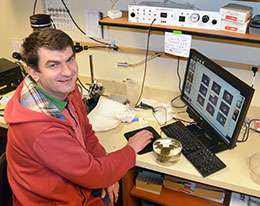Study of cells during frog development may aid future cancer patients

Two University of Wyoming researchers have found that scaling of cell and nuclear sizes shortly after fertilization contributes to the regulation of gene transcription and cell cycle elongation in African clawed frogs. Such scaling may have future implications for controlling the rate of cancerous growth in human cells.
Daniel Levy, a UW assistant professor in the Department of Molecular Biology, and Predrag Jevtic, a UW doctoral student in Molecular and Cellular Life Sciences, investigated how changes in the nuclear size of cells and the nuclear-to-cytoplasmic (N/C) volume ratio during early development of the frog cells contribute to the regulation of the timing of the Midblastula Transition or MBT. The MBT is a transition during the blastula stage of embryonic development in which zygotic gene transcription is activated.
"By changing the size of the nucleus, we can change the timing of the MBT. The MBT is the first really major transition during development," Levy says. "The idea is, if we can understand the normal cell development process, that could tell us what's going on in the disease state. Development, in some ways, can be considered a model for cancer. In early embryos, cells divide rapidly. It's similar to a cancer developing out of control."
Levy is a corresponding writer of a paper, titled "Nuclear-Size Scaling During Xenopus Early Development Contributes to Midblastula Transition Timing," which was published in the Dec. 4 issue (today) of Current Biology. Jevtic was lead writer of the paper. Current Biology is highly regarded among life scientists, and features research and commentary in all areas of biology.
"Part of the reason they (Current Biology) liked the paper is that it revisits an old developmental question," Levy says of the early 1980s discovery of the MBT being the first major transition during embryonic development.
"We're using a modern-day approach," says Jevtic, originally from Valjevo, Serbia.
While previous studies suggested a role for the N/C volume ratio in MBT, none directly tested the effects of altering nuclear size during the development process.
"Generally, the size of the nucleus scales with the size of the cell. That's been known," Levy says. "The mechanisms that regulate the size of the nucleus are, for the most part, not known."
Embryos from African clawed frogs were used because its eggs are large, approximately 10 times the size of a mammalian egg, Levy says. Also, frog embryos develop externally and the cells divide rapidly. And, as cells become smaller, so does nuclear size.
"The embryo goes through 12 rapid cell divisions after fertilization," Jevtic says. "It goes from one to 4,000 cells in about seven hours."
Approximately 4,000 cells represent the point of the MBT, which is critical for the later stages of embryonic development, Levy says.
Levy and Jevtic micro-injected frog embryos to over-express proteins of interest. These proteins were catalysts that led to changes in the size of the nucleus.
Their research data revealed that, when the size of the nucleus was increased, earlier or premature gene expression occurred, Jevtic say. On the flip side, when nuclear size was decreased, the two observed delayed zygotic gene expression.
"In cancer, developmental programs can get turned back on inappropriately. We can make the argument that understanding normal embryonic development will help us understand cancer development," Levy says. "If we can get a handle on what's regulating nuclear size, and we can show that the size of the nucleus has functional significance, we can imagine targeting cancer by reducing nuclear size in cancer cells."
"Cancer cells have bigger nuclei," Jevtic adds. "If we can decrease the nuclear size, we might reverse the cancer down the road."
More information: "Nuclear Size Scaling during Xenopus Early Development Contributes to Midblastula Transition Timing." DOI: 10.1016/j.cub.2014.10.051
Journal information: Current Biology
Provided by University of Wyoming




















